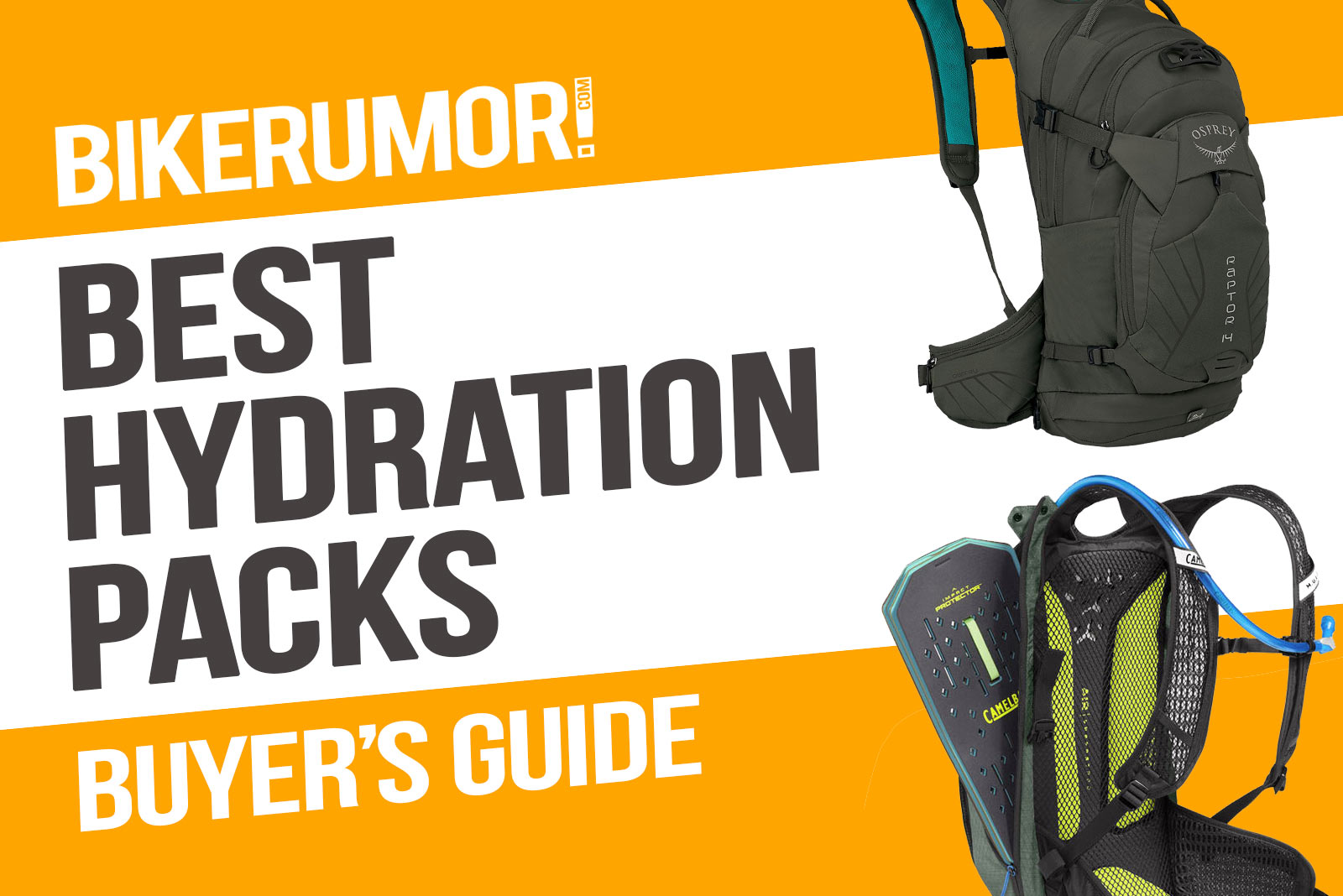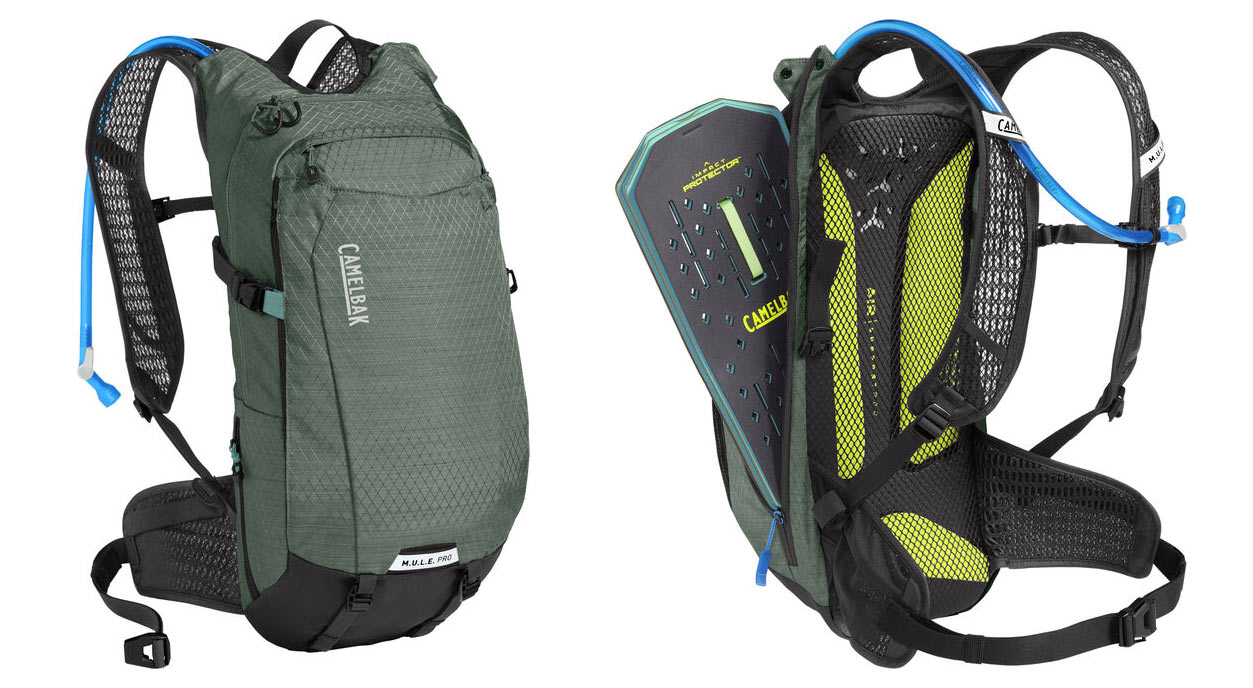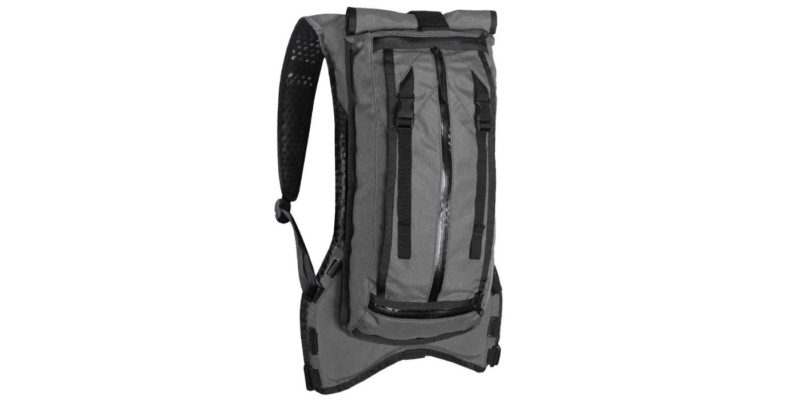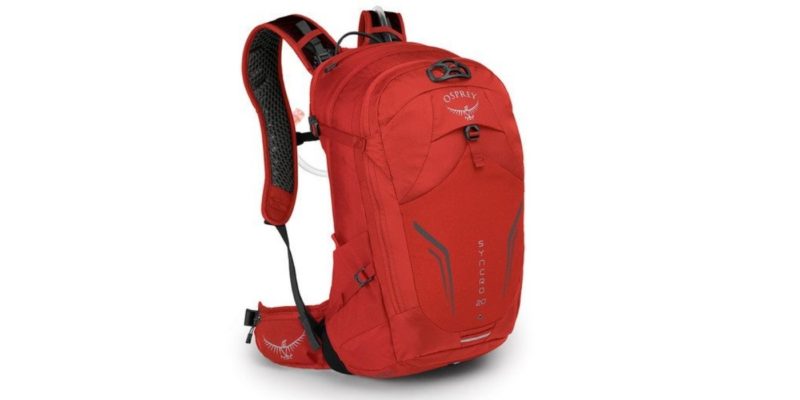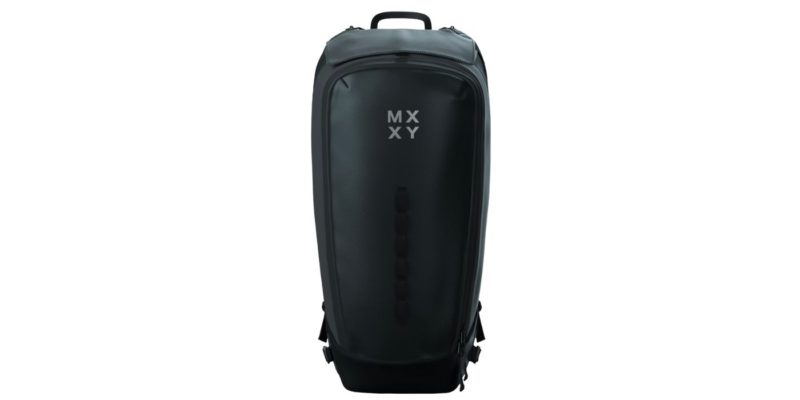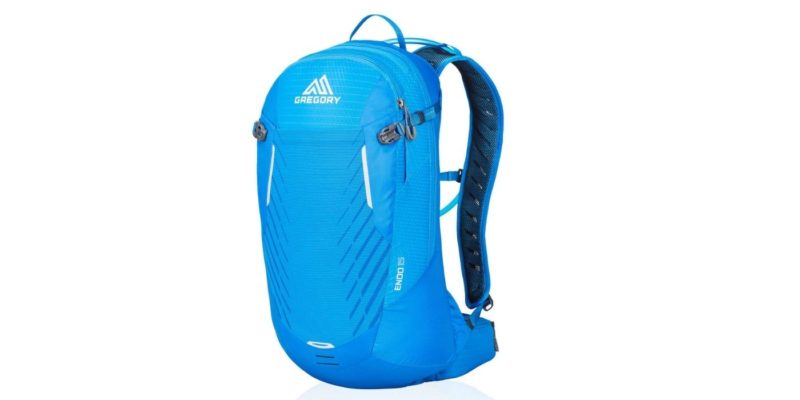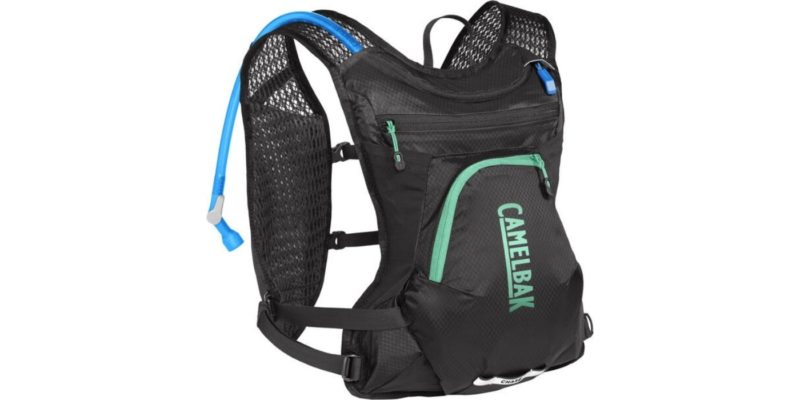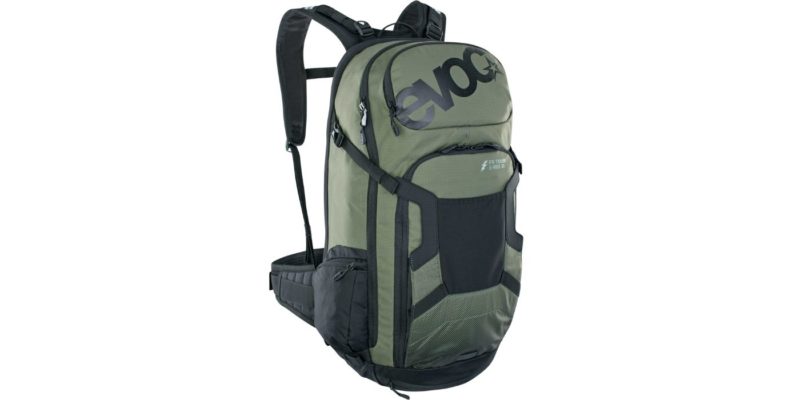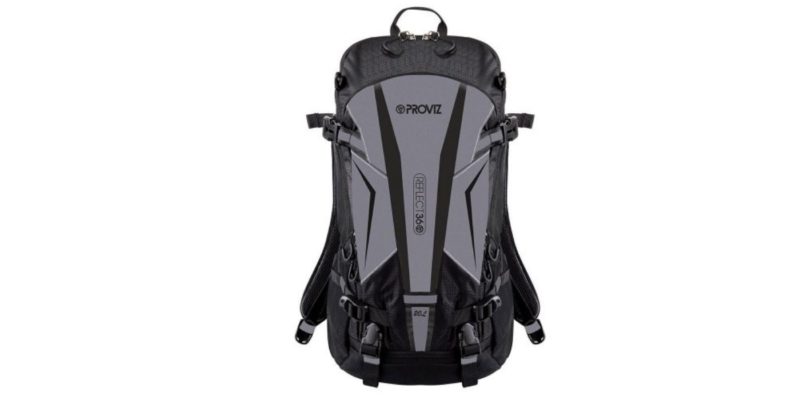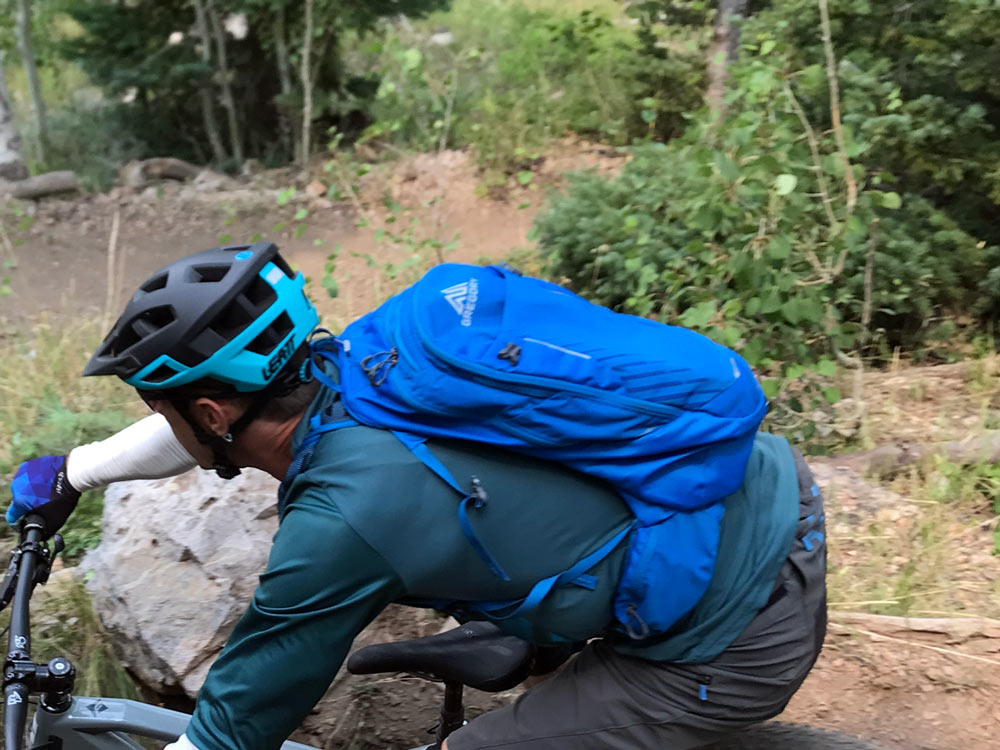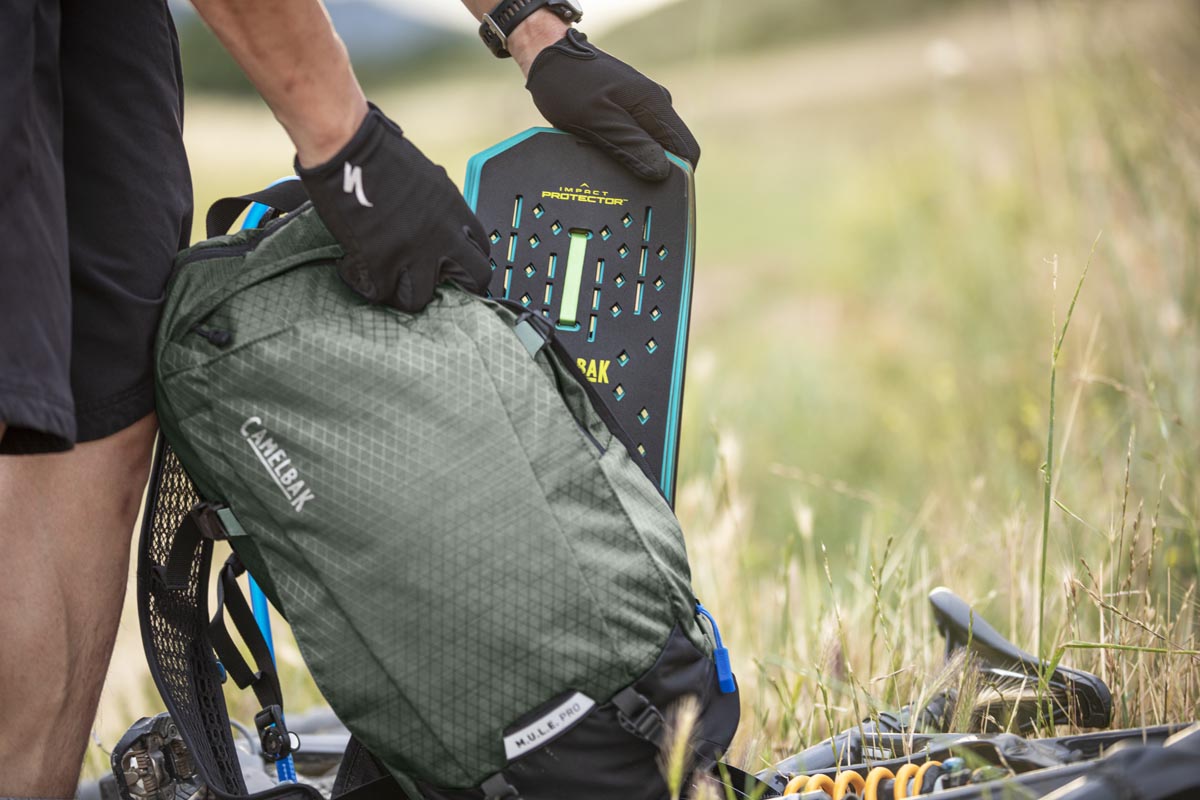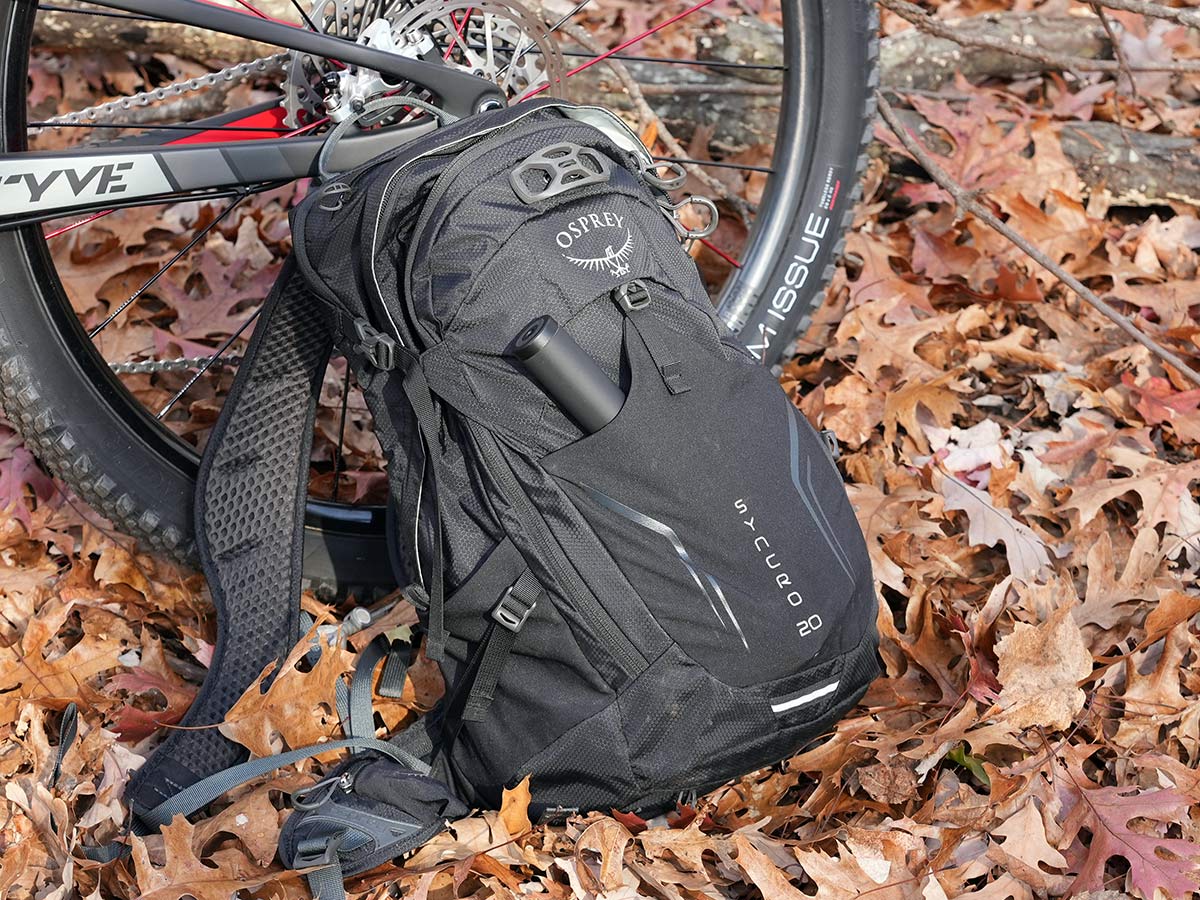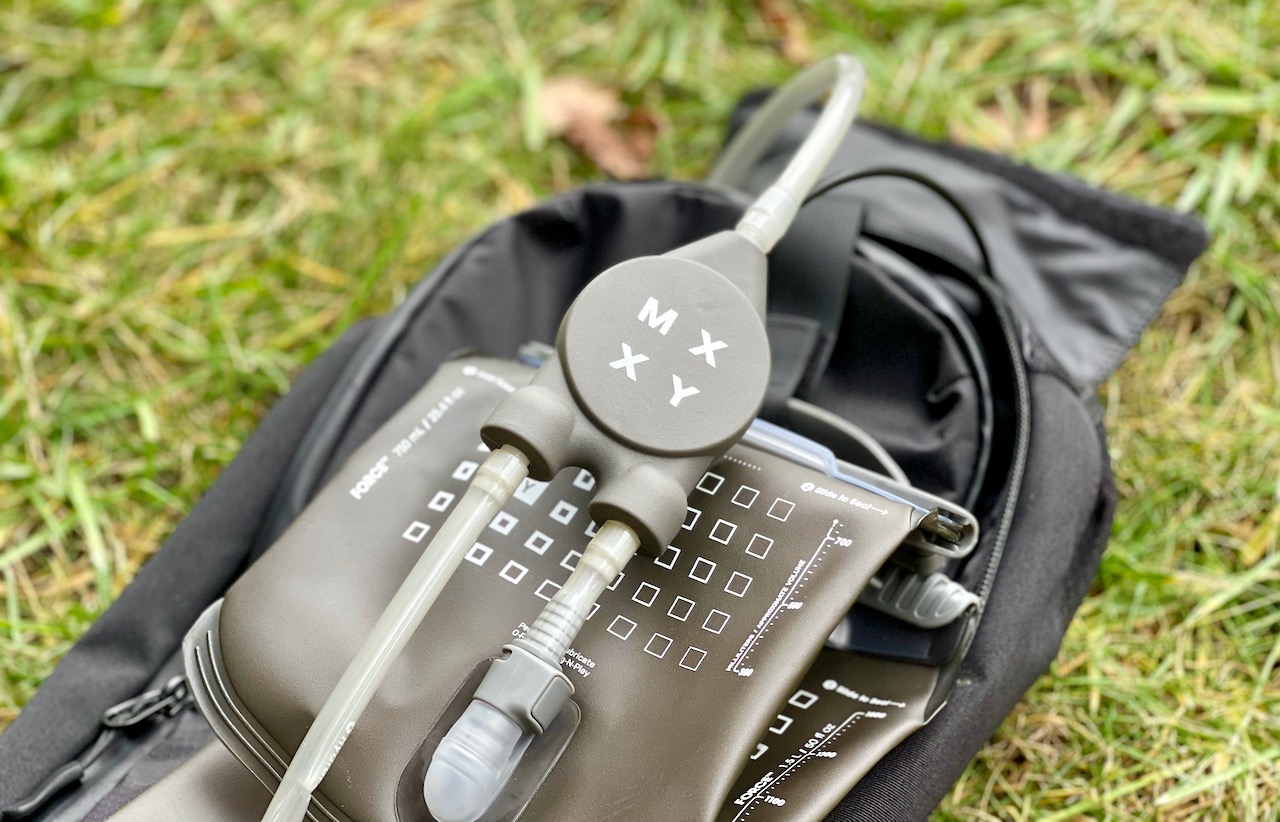Whether you’re mountain biking, gravel grinding, bikepacking, or just doing a long road ride or commute, a hydration pack or vest can be a great way to have all of your tools, snacks and water, no stuffed pockets or saddlebags required.
For coaches or cyclists who regularly lead group rides, a hydration pack can hold your first aid kit as well as extra snacks and supplies. Content creators can stuff their action cameras, batteries, and spare lenses and accessories in there.
Here, we’ve rounded up our favorite hydration packs for days when we want to be out for hours without stressing about the next water stop.
BEST ALL-AROUND PACK: Osprey Raptor
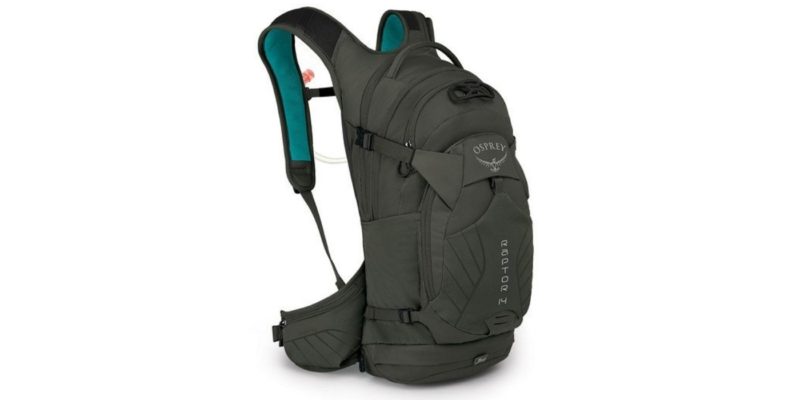
For an all-purpose MTB hydration pack, these have a great fit, and the zippered hip belt pockets make it easy to get to a tool or snack without having to take the pack off. It’s available in two sizes, 10L and 14L, which gives you options, and men’s and women’s versions tailor the fit to the gender (see the women’s version below).
We also like that Osprey’s colors are generally muted, so they won’t go out of style next season, which is great because they last a really long time. Lightweight yet durable materials, great padding, secure fit, logical pocket layouts, a place to clip your full-face helmet for enduro days, and internal organization make Osprey’s MTB packs some of our favorites.
The Raptor is just the right blend of plenty of space for big days that cinches down compactly for light days, making it a pack that works for almost every ride!
- Size options: 10 and 14L
- Reservoir size (included): 2.5 liter
- Tool wrap/pouch: Yes
- Rain cover: No
- Hip belt: Yes, with pockets
- Men’s/Women’s/Unisex: Men’s
- Weight: 1.59lb for 10L / 1.75lbs for 14L
- Price: $140 for 10L / $150 for 14L
PROS: Feels compact but plenty of space for all the extras, great pocket structure
CONS: None, really
BEST ENDURO PACK: Camelbak MULE Pro
Camelbak’s MULE PRO is our choice for a lightweight enduro pack thanks to its compatibility with their Impact Protector back pad. Some races require back protection, but it’s never a bad idea. For lighter days, just slide it out.
The pack itself is very light, as are the shoulder straps and waist belt. Those, plus the well-ventilated Air Support back panel, help you stay fresh even on the longest, hottest transfer stages (read: climbs!). It’s internal compartment design and zipper structure can make its 14L capacity seem a little cramped, but for racing that ends up helping to keep everything from bouncing around.
Side compression straps double as helmet straps, giving you somewhere to stow that full face for the climbs, while knee pads can go in the bottom loops. If you just need a cool, lightweight, and protective pack for enduro racing, this is it.
- Size options: 14L
- Reservoir size (included): 3 liter
- Tool wrap/pouch: Yes
- Rain cover: No
- Hip belt: Yes, with pockets
- Men’s/Women’s/Unisex: Unisex
- Weight: 1.87lb
- Price: $150
PROS: Light, airy, easy to add spine protection
CONS: Cramped cargo access, pocket layout isn’t great
MOST DURABLE PACK: Mission Workshop Hauser 14L
Prefer simplicity and ultimate durability? The Mission Workshop Hauser has served one editor faithfully for years, both as a mountain bike pack shoved full of camera gear, snacks, clothing, bike tools, and more, or as a hiking day pack for family adventures.
It’s expensive, but it’ll likely outlast every other hydration pack here by years, and the tough waterproof exterior and zippers keep your stuff dry and safe. There’s a small external pocket perfect for a smartphone and energy bar, and a medium outer pocket for things like a mini pump and the excellent oversized tool roll that comes with it. The main roll-top compartment is cavernous, and a small stealth side pocket stashes cash, cards, or even a passport.
A smaller 10L version is great for all-day gravel rides or smaller riders, as the 14L pack is kinda tall (but the adjustable lower shoulder strap points let you adjust the fit). Bonus features like a clamshell reservoir pocket that opens all the way, three-position removable waist belt, and two adjustable loops for securing knee pads, a helmet, or extra jacket, all add up to make this an extremely functional pack that looks sharp and lasts forever.
- Size options: 10L and 14L
- Reservoir size (included): Fits up to 3L, but reservoir not included
- Tool wrap/pouch: Yes
- Rain cover: No
- Hip belt: Yes
- Men’s/Women’s/Unisex: Unisex
- Weight: 2.1lbs
- Price: $230
PROS: Long-lasting, versatile, and will stay in style for years
CONS: Pricey
BEST ALL-DAY PACK: Osprey Syncro 20
The Osprey Syncro 20 is great for all-day adventures. It has a comfortable fit even when fully loaded. Zippered hip belt pockets make getting to a mini-tool or gel super quick and easy, and it’s big enough for a DSLR and GoPro plus all of the mounts and accessories you might need for a day out shooting pictures while shredding.
A raised, breathable mesh back panel keeps it off your back so you don’t get sweaty, even when carrying a lot of gear, and well-padded, multi-adjustable shoulder straps make it comfy. Compression straps keep it compact when not fully loaded down, but make no mistake, this is a big pack. It’s lightweight at under 2 pounds, but it’s definitely an all-day pack, not a ‘chill ride with a bottle and a bar’ pack.
Other key features include an elastic helmet attachment, stretchy side and back stash pockets, a reflective blinky light loop, hidden hi-viz rain cover, and excellent interior organization and access.
- Size options: 20 liters
- Reservoir size (included): 2.5 liters
- Tool wrap/pouch: No
- Rain cover: Yes
- Hip belt: Yes, with pockets
- Men’s/Women’s/Unisex: Men’s
- Weight: 1.95 pounds
- Price: $150
PROS: All the bells and whistles, super comfortable even when fully loaded
CONS: Might be overkill for casual riders
BEST TECH: MXXY Pack
We love the new design from MXXY that allows riders the option of sports drink and plain water, simultaneously. This pack allows you to really dial in how you drink on the bike thanks to a dual bladder-and-hose system with a control dial that lets you control how much of each comes through in each sip. This lets riders mix the sports drink and the water to deliver specific hydration and electrolyte/calorie levels.
It uses two Hydrapak bladders – one 0.75L and one 1.5L – which are easy to close and are dishwasher-friendly. Otherwise, it’s a simple pack – riders looking for a lot of features like pockets and extras like rain covers may not love the MXXY pack, since it’s very minimalist other than the reservoir design. (Read our full review here.) Like the idea but wanna keep your full-featured pack? They sell the dual bladder and dial/hose system separately, too.
- Size options: 17 x 10 x 8 inches
- Reservoir size (included): 2.25 liters total
- Tool wrap/pouch: No
- Rain cover: No
- Hip belt: Yes
- Men’s/Women’s/Unisex: Unisex
- Weight: 2.3 pounds
- Price: $199
PROS: Perfect for riders who want some water, some sports drink
CONS: The water switch feature might be overkill for riders who stick with water—this is a niche pack!
BEST WOMEN’S PACK: Osprey Raven
Take all the benefits of the Raptor above, like zippered hip belt pockets and comfy padding and strap, then tailor make it for a woman’s body. The Raven is available in the same two sizes, 10L and 14L, so it’s not smaller, it’s just been optimized for typical women’s geometry.
That means it’s slightly shorter, and takes chest size into consideration with strap placement and fit—you can compare this image with the one above to see the slight changes. We also like that Osprey’s colors are generally muted (even for the women’s packs, which often end up bright and neon) so they’ll go with most kits, season after season. The bottom external zippered pouch keeps the included tool roll in easy reach without having to dig through the main compartment.
- Style: Pack
- Size options: 10 and 14L
- Reservoir size (included): 2.5 liter
- Tool wrap/pouch: Yes
- Rain cover: No
- Hip belt: Yes, with pockets
- Men’s/Women’s/Unisex: Women’s
- Weight: 1.59lb for 10L / 1.63lbs for 14L
- Price: $140 for 10L / $150 for 14L
PROS: Appreciate that they didn’t “shrink and pink” the Osprey Raptor
CONS: None, really
BEST ORGANIZED PACK: Gregory Endo 15
This one made our Editor’s Choice list in 2018 thanks to it’s incredibly good fit and excellent organization—and we still love and use it regularly.
Internal sleeves keep tire and shock pumps from sliding around, and an included tool pouch makes it easy to grab your repair kit and safely lay it out trailside. Zippered hip belt pockets fit a mini tool and snacks, and a clever sunglasses bungee loop on the shoulder strap keeps you from losing them. 15L sounds big, and it’ll hold a lot, but pulls this trick off without looking bulky or overly technical.
Gregory’s history of making killer hiking packs shows on their debut MTB effort, even down to their easy-to-use reservoir design. They also have a women’s version available—the Avos—that offers the same size and features, just with tweaks to the fit to work better with women’s bodies.
- Size options: 15L
- Reservoir size (included): 3 liters
- Tool wrap/pouch: Yes
- Rain cover: No
- Hip belt: Yes
- Men’s/Women’s/Unisex: Men (but women can opt for the Avos)
- Weight: 2.03lbs
- Price: $140
PROS: Big reservoir, great organization, sleek look
CONS: Some people find the hose is too short
BEST VEST: CamelBak Chase Vest 50-Ounce
If you don’t like how most backpacks fit, or you find hip packs and waist belts to be uncomfortable, the CamelBak Chase Vest might be exactly what you need. This vest is comfortable for long rides and has the benefit of allowing riders to stash both a phone and snacks in the front pockets of the vest for much easier access. With the size of phones now, it’s almost impossible to find a pack that allows a phone in the hip pocket (and that could prove disastrous in a crash anyway), so this keeps it handy for quickly answering a call or, more importantly, snapping a mid-ride photo.
The main compartment has just enough room for a tool, tube, and a spare raincoat in addition to a 1.5-liter bladder. And it’s ideal if you do some off-season trail running and want a vest that works well for both sports. The one downside: Camelbak’s reservoir’s lids have tendency to leak if not screwed on perfectly, and they can be tricky to fill on the go because they have such a wide mouth.
- Size options: 2.5 liters
- Reservoir size (included): 1.5 liter
- Tool wrap/pouch: No
- Rain cover: No
- Hip belt: No
- Men’s/Women’s/Unisex: Available in men’s and women’s
- Weight: .625lb without bladder
- Price: $100
PROS: Great for minimalists who need more water, easy phone/snack access, super stable fit
CONS: Shape balloons when full of water, Camelbak bladder lid can be temperamental when it screws on (if it’s not screwed on perfectly, it may leak)
BEST e-BIKE PACK: EVOC FR Tour E-ride 30
The EVOC FR Tour E-ride 30 is easily the best e-MTB hydration pack. It’s specifically made to carry an extra battery and protect it in a crash. The well padded, oversized hip belt helps stabilize the extra weight and shift some of the load to your hips, helping save your shoulders and keeping you more nimble on the bike.
While it doesn’t come with a hydration bladder, it does have a compartment for one, and we appreciate the organization it provides with its numerous pockets. It’s definitely designed around hours-long e-bike tours, so it may be overkill for casual riders, but for that purpose, it is the absolute best.
- Size options: 30L
- Reservoir size (included): No hydration bladder included, though it does have a compartment for one
- Tool wrap/pouch: No (but has tool compartment)
- Rain cover: No
- Hip belt: Yes, with pockets
- Men’s/Women’s/Unisex: Unisex
- Weight: 3.57lbs
- Price: $280
PROS: Perfect for adventurous e-bike riders
CONS: Overkill for casual riding
BEST BUDGET/COMMUTER: Proviz Sports REFLECT360 Touring Backpack
Need a big pack that fits lots of stuff for a casual MTB ride or an office commute? Meet the budget-friendly 20-liter Proviz Sports REFLECT360 Touring Backpack, available in several ridiculously high-vis, brilliantly reflective colorways.
We appreciate that this pack can be seen in any condition, and that it’s meant to work well in pretty much any situation. Mountain biking or hiking? No problem. Commuting to work? Sure, and there’s even a pocket for your 12” laptop to slide in—and a cover for when it starts raining during your ride. It even has a detachable phone pocket that can be attached to the front strap, bike messenger style.
- Size options: 20L
- Reservoir size (included): No hydration bladder included, though it does have a compartment for one
- Tool wrap/pouch: No
- Rain cover: Yes
- Hip belt: Yes, with pockets
- Men’s/Women’s/Unisex: Unisex
- Weight: 1.8lbs
- Price: $85
PROS: Great price and super versatile, keeps you highly visible in traffic
CONS: Fit and feel not as secure for true mountain biking
Buyer’s Guide for MTB Hydration Packs
Buying a hydration pack can be a little tricky, since there are so many factors at play. There’s the pack size, the bladder size, the shape and style of the straps, and of course, a little bit of aesthetic as well.
Size:
Riders who don’t do huge mileage can likely stay small with a 10L or 14L pack. And all-day riders (MTB and gravel in particular) may want a pack that will fit a 3-liter bladder. Remember, the volume a pack can hold doesn’t refer to water, and it might sound bigger than it looks. A 14 liter pack, like the Osprey Raven, will only have a 2.5 liter bladder—the rest of the space is for tools and spare clothing/snacks…or maybe even an extra bottle with sports drink.
Straps:
Most of the packs we’ve listed here are standard ‘packs,’ meaning they have straps that are similar to backpacks, plus a hip and chest strap to keep them in place. For most cyclists, these are perfectly comfortable. Some cyclists—especially those who dabble in trail running—may prefer a vest-style pack, though. These packs have more pockets in the front and tend to be shorter (and they skip the hip belt altogether). Vests may also be preferable for riders who struggle with any kind of gut issues, since hip straps can occasionally feel uncomfortable if you tend to bloat mid-ride.
Types of rides you’ll do:
If you’re doing downhill or enduro, look for a pack like the Camelbak MULE Pro that offers back protection. You may also want the ability to clip your full-face helmet onto your pack while you climb, so look for a pack that has a helmet strap/lock system. For cross-country riders and gravel grinders, prioritize comfort and assume that you won’t need to carry everything but the kitchen sink. Coaches and ride leaders may want extra space for spare supplies. And commuters may prefer something that comes with a rain cover or is designed to be high vis and fit office supplies like laptops in addition to water bladders.
Fit:
It has to be said that not every woman will find a women’s-specific pack more comfortable, and the reverse is true as well. Men who are on the shorter, stockier side may actually find that a pack like the Osprey Raven is better than the Raptor because it’s a little shorter, for example. And unfortunately, not a lot of packs are designed with bigger riders in mind, so riders with broader frames or bigger chests may need to try a few before finding the right one.
Color:
As a rule, we recommend going neutral on your pack unless you absolutely love the bright-colored option. Because you’ll use the pack for (hopefully) years, a neutral color is ideal since you can continue to change your kit without worrying about clashing. For some people, this isn’t an issue at all, but if you care about your riding aesthetics, stick to the simple colors.
Hydration bladder:
There are pros and cons to each bladder, so consider your riding and personal preferences. Remember, you can always buy another bladder and swap it out. So if you love the Camelbak Chase Vest, but want a bladder that seals on the top and is insulated to keep water cold, you can simply buy a Nathan insulated hydration bladder to use instead. The bite valve on the hose is also a personal preference. Some love the free flow from a Camelbak, but some prefer the slower flow of Osprey or Nathan’s hydration bladders. Opt for brand names here, though: Cheap hydration bladders that are sub $20 on Amazon are incredibly leak- and puncture-prone.
Look for good return policies:
As we mentioned, you may need to try a few packs before you find the one that fits the best. If you order one, try it on by carefully stuffing it with some clothing or other material so it’s fully packed (otherwise the fit when it is full may feel different), then put it on and adjust, then test it either carefully on your bike or at least sitting on a trainer in your normal riding position. A pack that feels good standing up may hit wrong when you’re bent over, and vice versa, so it’s always worth testing in position and loaded with water and gear.
Frequently Asked Questions about MTB Hydration Packs
What size pack do I need?
It depends on how much you want to carry and how much water you want to bring with you. Typically, packs that hold 14 liters and under come with 1.5 to 2.5-liter bladders. Quick math on cycling nutrition suggests that you should drink roughly half a liter every hour on the bike, so a 1.5-liter bladder should be just about enough for a three-hour ride. (We recommend erring on the side of having extra water!)
Planning to go longer and not sure if you’ll be able to refill? A pack that can fit a 3-liter bladder is a good call. You also should think through what you want to carry. For riders who go deep into the wilderness, packs can fill up fast with snacks, tools, flat-fixing gear, first aid, and extra clothing. But for casual mountain bikers shredding local trails, a 10L pack is perfectly adequate. A bigger pack doesn’t make a better rider!
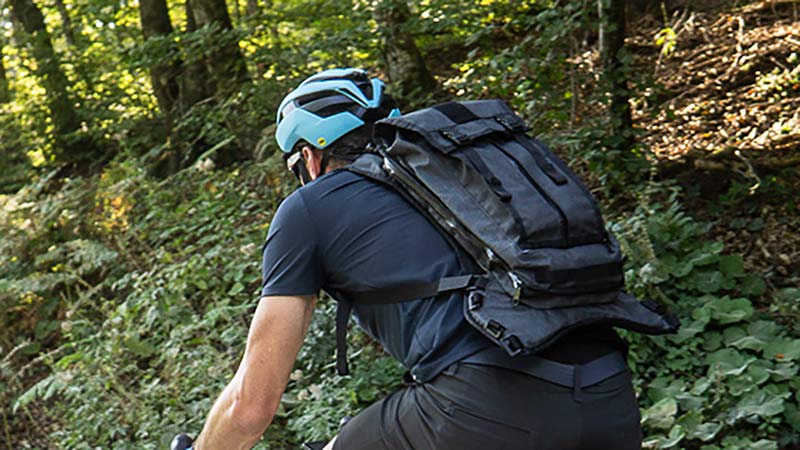
Pack or vest or hip pack?
As we mentioned above in the buyer’s guide, it’s subjective whether you prefer a backpack to a vest for your hydration pack. You may have to try a few to find your favorite. We didn’t list fanny packs here, but that’s not because we hate them. On the contrary, we actually really love a fanny pack, and we’re working on a full list of our favorites. Fannypacks are great for shorter rides and hotter days, since they don’t add to the back sweat situation, and may work better for larger riders who struggle to find packs that fit comfortably.

What should I carry in my hydration pack?
Whatever you need for your ride! Think of the pack as a jersey pocket extension.
- Snacks
- Hydration bladder
- First-aid supplies & sunscreen
- Extra clothes: Raincoat, gloves, wool cap, depending on your environment
- Sunglasses
- Phone
- Multitool
- Tire plugs, spare tubes and patches, mini-pump, CO2s, et cetera
Can I keep water warm while fat biking?
Yes, but it takes some ingenuity. In sub-freezing temps, your bladder may stay liquid, but the hose and nozzle can get filled with ice, making drinking impossible. You can avoid this by wearing a layer over your pack, keeping your hose tucked into your jacket except for when you’re drinking. And don’t go long periods without drinking: The more you drink, the less time the water has to sit in the nozzle freezing. Keep the water moving in the hose by drinking every few minutes. Some brands sell neoprene sleeves that insulate your drinking hose, which works well, too.
How do I clean a hydration pack?
Some bladders, like those made by HydraPak, are dishwasher safe. But many aren’t. If you just drink water, just pour it out and leave it to dry after your ride and that’s likely enough. Or throw it in the fridge if you’re going to ride with it again in the next couple days.
When it does need a proper cleaning, filling it with warm water and dish soap, shaking vigorously and letting the pack soak and sending the soapy water through the hose and nozzle works. A gentle bottle brush can help if it’s started to build up a coating inside, and even a drop of bleach in the water if things get real bad. Then rinsing it well and sending fresh water through the hose to clear out the soap.
Let it dry completely by making sure that it’s propped open so air can get in. If the pack can do it, just turn it inside out to dry.
If you do use sports drink mix, you may also want to take the hose and nozzle apart and soak and clean them separately as well, since the sugary drinks can lead to mold. At the minimum, rinse your pack after every use, and don’t leave sugar water sitting in it for days at a time. Keep it dry when not in use. For more thorough cleanings, most brands offer cleaning kits to help you get into all the nooks and crannies of your pack.
For the pack itself, make sure that you’re washing it every so often as well. This could just mean hosing it off when you clean your bike, or running it through the washer. Your friends will thank you…trust us, these can build up funk just like a jersey. Just don’t put it in the dryer!
